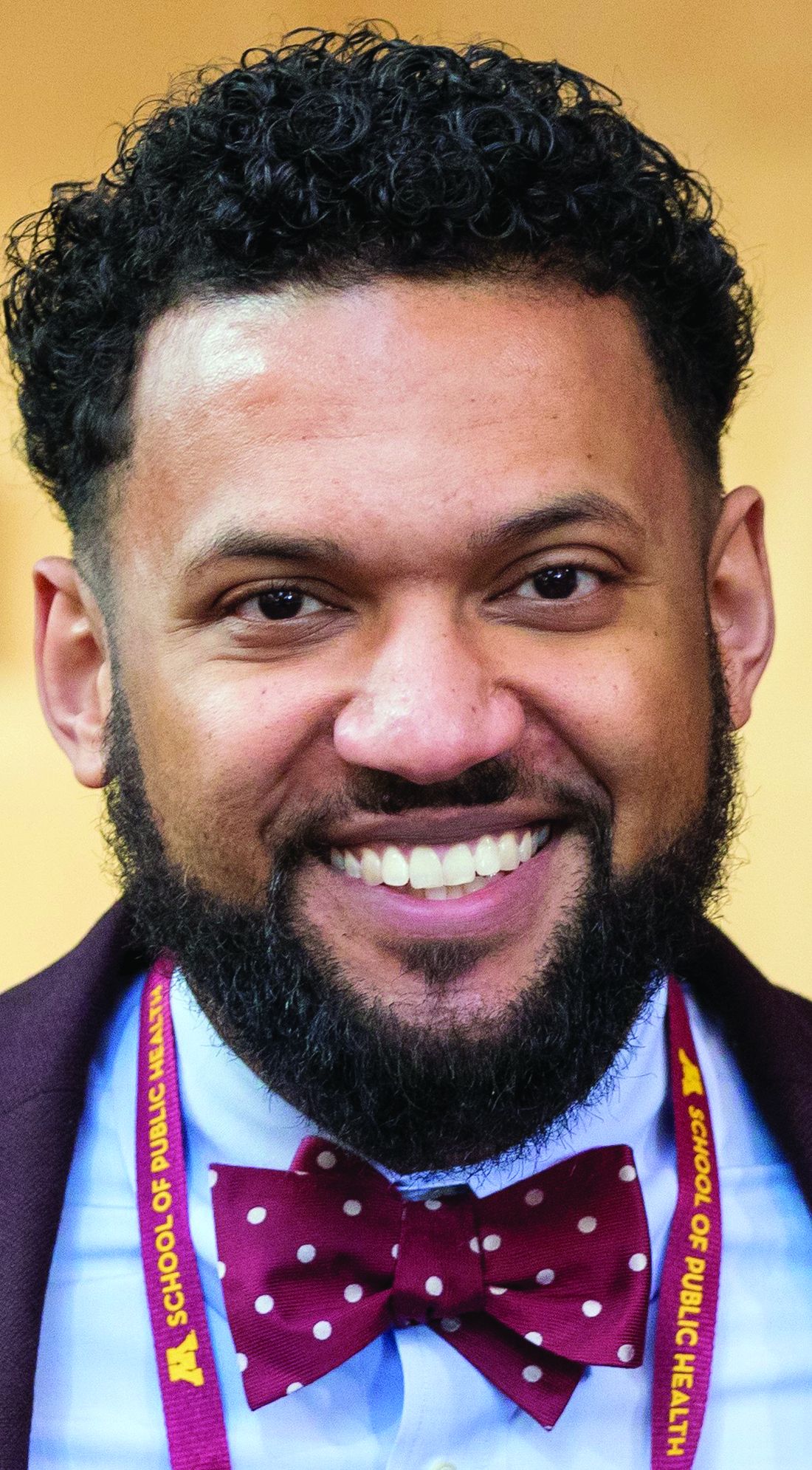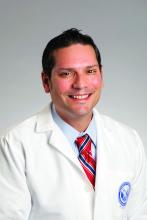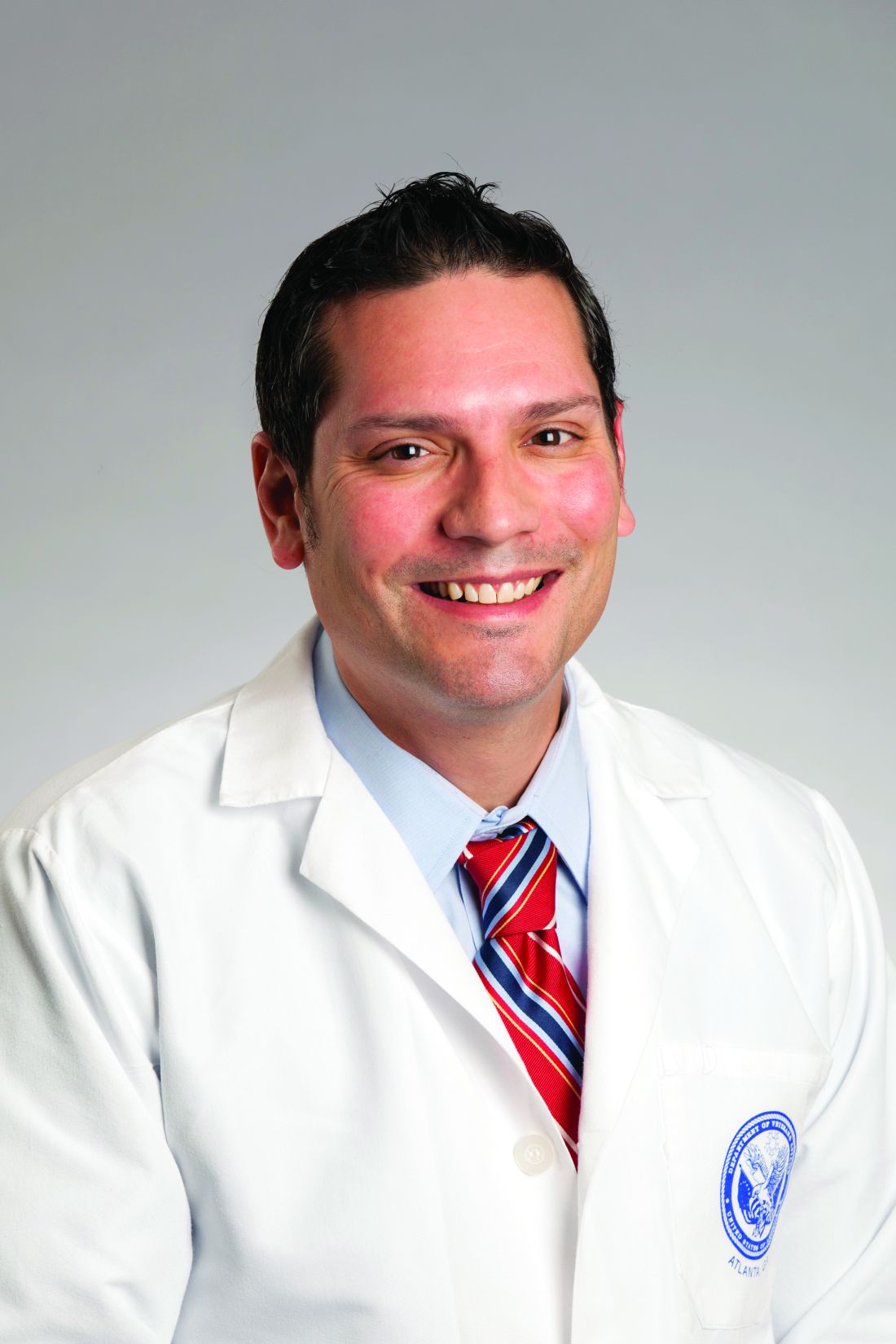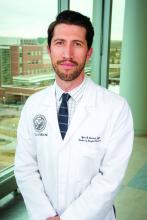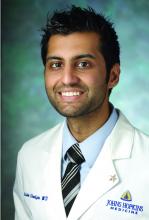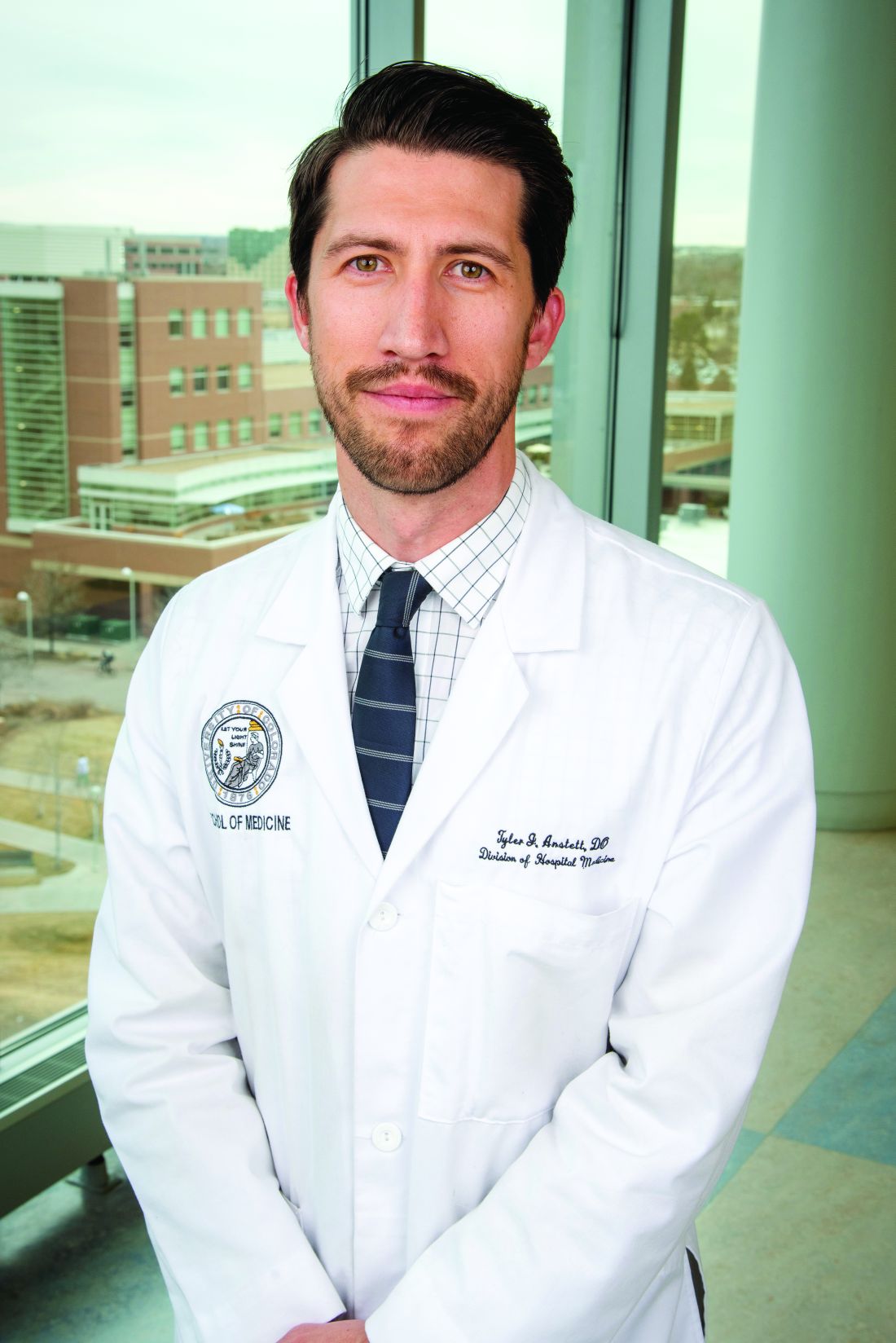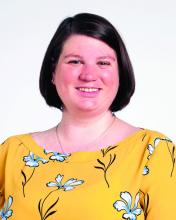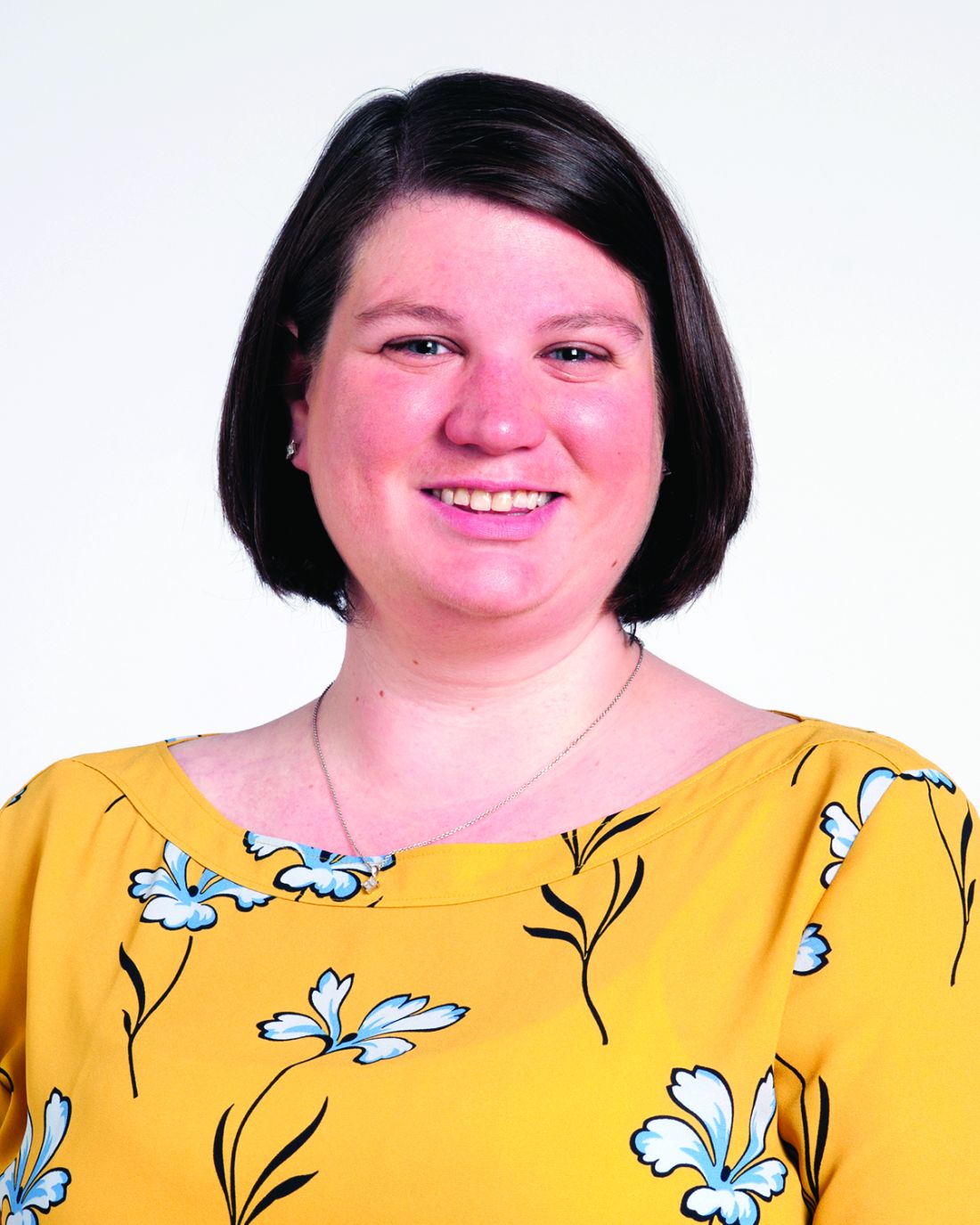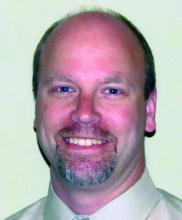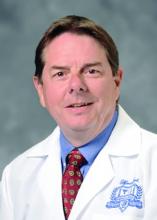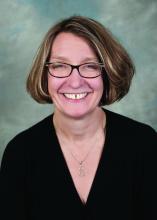User login
HM20 Virtual: Experts to discuss structural racism in hospital medicine
Nathan Chomilo, MD, the Medicaid medical director for the state of Minnesota and assistant adjunct professor of pediatrics at the University of Minnesota, Minneapolis, was prepared to deliver a talk on structural racism in the U.S. health care system at Hospital Medicine 2020 meeting (HM20) in April 2020. But that changed in the COVID-19 era.
When the pandemic hit, the problems Dr. Chomilo was going to point out began to play out dramatically around the country: Black, Indigenous, and Latinx people – many of them under-insured; in high-exposure, frontline jobs; and already burdened with health comorbidities – are at a higher risk of contracting COVID-19 and dying from it.
He will now be giving his talk at HM20 Virtual in a session called “Structural Racism and Bias in Hospital Medicine During Two Pandemics,” with the powerful narrative of COVID-19 to get his message to sink in:
“It’s something that’s been going on since the start of our country,” said Dr. Chomilo, who is also a founding member of Minnesota Doctors for Health Equity. Physicians, he said, participated in upholding the institution of slavery by trying to describe the physical discrepancies between White people and non-White people.
Now, the way health care is provided in the United States fundamentally favors Whites over Black, Indigenous, and Latinx patients.
“We have a health care system here in the United States that is based on employer-sponsored insurance,” he said. “And who has had access to those jobs over the course of our country’s history has been mostly White people.” That impacts who is more at risk of contracting the virus, who is able to shelter in place, and who has the financial reserves to withstand furloughs and unemployment.
In a recent blog post in Health Affairs, Dr. Chomilo and his coauthors discussed articles from the New England Journal of Medicine and the Journal of the American Medical Association that try to offer an ethical framework for allocating scarce medical resources – such as intensive-care beds and ventilators – during the pandemic.
“Unfortunately, neither article acknowledged the structural racial inequities that inherently bias its proposals, nor did either piece adequately acknowledge how its care rationing plan might worsen already racially disparate health outcomes,” Dr. Chomilo and his coauthors wrote. For instance, the life expectancy of a White female in the United States is 81 years, compared with 72 years for Black males, and any allocation plan that prioritizes preserving years of life would automatically be tilted against black patients.
In his talk, Dr. Chomilo will also discuss how physicians can make a difference by looking at their own perceptions and habits and then start helping others and the systems in which they work.
“The first thing is, we have to look at ourselves,” he said.
In the same session, Benji Mathews, MD, SFHM – chief of hospital medicine at Regions Hospital in St. Paul, Minn., which is part of HealthPartners; associate professor of medicine at the University of Minnesota, Minneapolis; and the Annual Conference’s course director – said he will be discussing the way social inequities are “patterned by place” and how resources for staying healthy vary neighborhood to neighborhood. He will point to dense housing and multigenerational households as a chief driver of COVID-19 infection risk. People of color are often “first fired, last hired, and in the front lines of fire,” he said, and they are experiencing a more severe impact from the pandemic.
And he will get deeper into the other disparities that track along racial lines, such as insurance disparities. For instance, the percentage of African Americans on Medicaid is three times as high as the percentage of White, non-Hispanic patients, he said.
Dr. Mathews will also discuss race’s role in the biases that everyone has and how health care professionals might, with deliberate reflection, be able to reshape or mitigate their own biases and deliver care more equitably.
“The associations we have, and our biases, are not necessarily declared beliefs or even reflect our stances that we explicitly endorse – sometimes it comes through in our default stance, and generally favor our in-group,” he said. “These implicit biases are malleable, so that allows us some hope. There are some ways they can be unlearned or progressively acted upon with some coaching – some active, intentional development.”
Structural Racism and Bias in Hospital Medicine During Two Pandemics
Nathan Chomilo, MD, the Medicaid medical director for the state of Minnesota and assistant adjunct professor of pediatrics at the University of Minnesota, Minneapolis, was prepared to deliver a talk on structural racism in the U.S. health care system at Hospital Medicine 2020 meeting (HM20) in April 2020. But that changed in the COVID-19 era.
When the pandemic hit, the problems Dr. Chomilo was going to point out began to play out dramatically around the country: Black, Indigenous, and Latinx people – many of them under-insured; in high-exposure, frontline jobs; and already burdened with health comorbidities – are at a higher risk of contracting COVID-19 and dying from it.
He will now be giving his talk at HM20 Virtual in a session called “Structural Racism and Bias in Hospital Medicine During Two Pandemics,” with the powerful narrative of COVID-19 to get his message to sink in:
“It’s something that’s been going on since the start of our country,” said Dr. Chomilo, who is also a founding member of Minnesota Doctors for Health Equity. Physicians, he said, participated in upholding the institution of slavery by trying to describe the physical discrepancies between White people and non-White people.
Now, the way health care is provided in the United States fundamentally favors Whites over Black, Indigenous, and Latinx patients.
“We have a health care system here in the United States that is based on employer-sponsored insurance,” he said. “And who has had access to those jobs over the course of our country’s history has been mostly White people.” That impacts who is more at risk of contracting the virus, who is able to shelter in place, and who has the financial reserves to withstand furloughs and unemployment.
In a recent blog post in Health Affairs, Dr. Chomilo and his coauthors discussed articles from the New England Journal of Medicine and the Journal of the American Medical Association that try to offer an ethical framework for allocating scarce medical resources – such as intensive-care beds and ventilators – during the pandemic.
“Unfortunately, neither article acknowledged the structural racial inequities that inherently bias its proposals, nor did either piece adequately acknowledge how its care rationing plan might worsen already racially disparate health outcomes,” Dr. Chomilo and his coauthors wrote. For instance, the life expectancy of a White female in the United States is 81 years, compared with 72 years for Black males, and any allocation plan that prioritizes preserving years of life would automatically be tilted against black patients.
In his talk, Dr. Chomilo will also discuss how physicians can make a difference by looking at their own perceptions and habits and then start helping others and the systems in which they work.
“The first thing is, we have to look at ourselves,” he said.
In the same session, Benji Mathews, MD, SFHM – chief of hospital medicine at Regions Hospital in St. Paul, Minn., which is part of HealthPartners; associate professor of medicine at the University of Minnesota, Minneapolis; and the Annual Conference’s course director – said he will be discussing the way social inequities are “patterned by place” and how resources for staying healthy vary neighborhood to neighborhood. He will point to dense housing and multigenerational households as a chief driver of COVID-19 infection risk. People of color are often “first fired, last hired, and in the front lines of fire,” he said, and they are experiencing a more severe impact from the pandemic.
And he will get deeper into the other disparities that track along racial lines, such as insurance disparities. For instance, the percentage of African Americans on Medicaid is three times as high as the percentage of White, non-Hispanic patients, he said.
Dr. Mathews will also discuss race’s role in the biases that everyone has and how health care professionals might, with deliberate reflection, be able to reshape or mitigate their own biases and deliver care more equitably.
“The associations we have, and our biases, are not necessarily declared beliefs or even reflect our stances that we explicitly endorse – sometimes it comes through in our default stance, and generally favor our in-group,” he said. “These implicit biases are malleable, so that allows us some hope. There are some ways they can be unlearned or progressively acted upon with some coaching – some active, intentional development.”
Structural Racism and Bias in Hospital Medicine During Two Pandemics
Nathan Chomilo, MD, the Medicaid medical director for the state of Minnesota and assistant adjunct professor of pediatrics at the University of Minnesota, Minneapolis, was prepared to deliver a talk on structural racism in the U.S. health care system at Hospital Medicine 2020 meeting (HM20) in April 2020. But that changed in the COVID-19 era.
When the pandemic hit, the problems Dr. Chomilo was going to point out began to play out dramatically around the country: Black, Indigenous, and Latinx people – many of them under-insured; in high-exposure, frontline jobs; and already burdened with health comorbidities – are at a higher risk of contracting COVID-19 and dying from it.
He will now be giving his talk at HM20 Virtual in a session called “Structural Racism and Bias in Hospital Medicine During Two Pandemics,” with the powerful narrative of COVID-19 to get his message to sink in:
“It’s something that’s been going on since the start of our country,” said Dr. Chomilo, who is also a founding member of Minnesota Doctors for Health Equity. Physicians, he said, participated in upholding the institution of slavery by trying to describe the physical discrepancies between White people and non-White people.
Now, the way health care is provided in the United States fundamentally favors Whites over Black, Indigenous, and Latinx patients.
“We have a health care system here in the United States that is based on employer-sponsored insurance,” he said. “And who has had access to those jobs over the course of our country’s history has been mostly White people.” That impacts who is more at risk of contracting the virus, who is able to shelter in place, and who has the financial reserves to withstand furloughs and unemployment.
In a recent blog post in Health Affairs, Dr. Chomilo and his coauthors discussed articles from the New England Journal of Medicine and the Journal of the American Medical Association that try to offer an ethical framework for allocating scarce medical resources – such as intensive-care beds and ventilators – during the pandemic.
“Unfortunately, neither article acknowledged the structural racial inequities that inherently bias its proposals, nor did either piece adequately acknowledge how its care rationing plan might worsen already racially disparate health outcomes,” Dr. Chomilo and his coauthors wrote. For instance, the life expectancy of a White female in the United States is 81 years, compared with 72 years for Black males, and any allocation plan that prioritizes preserving years of life would automatically be tilted against black patients.
In his talk, Dr. Chomilo will also discuss how physicians can make a difference by looking at their own perceptions and habits and then start helping others and the systems in which they work.
“The first thing is, we have to look at ourselves,” he said.
In the same session, Benji Mathews, MD, SFHM – chief of hospital medicine at Regions Hospital in St. Paul, Minn., which is part of HealthPartners; associate professor of medicine at the University of Minnesota, Minneapolis; and the Annual Conference’s course director – said he will be discussing the way social inequities are “patterned by place” and how resources for staying healthy vary neighborhood to neighborhood. He will point to dense housing and multigenerational households as a chief driver of COVID-19 infection risk. People of color are often “first fired, last hired, and in the front lines of fire,” he said, and they are experiencing a more severe impact from the pandemic.
And he will get deeper into the other disparities that track along racial lines, such as insurance disparities. For instance, the percentage of African Americans on Medicaid is three times as high as the percentage of White, non-Hispanic patients, he said.
Dr. Mathews will also discuss race’s role in the biases that everyone has and how health care professionals might, with deliberate reflection, be able to reshape or mitigate their own biases and deliver care more equitably.
“The associations we have, and our biases, are not necessarily declared beliefs or even reflect our stances that we explicitly endorse – sometimes it comes through in our default stance, and generally favor our in-group,” he said. “These implicit biases are malleable, so that allows us some hope. There are some ways they can be unlearned or progressively acted upon with some coaching – some active, intentional development.”
Structural Racism and Bias in Hospital Medicine During Two Pandemics
Rapid establishment of therapeutic protocols during the pandemic
Summary
Evidence on emerging therapeutics and the treatment of COVID-19 and its complications has been incomplete, often contradictory, and rapidly changing. The brisk development of effective strategies aimed at identifying, isolating, and treating this disease requires an equally fluid response. At Dell Seton Medical Center, a safety-net hospital that serves Austin in central Texas, our hospitalists have led the formation of numerous collaborative work groups to address the appropriate triage, management, and operational processes during the COVID-19 evolving pandemic.
We created a hospitalist-led COVID Therapeutics and Informatics Committee composed of specialists (infectious disease, pulmonary and critical care, hematology/oncology, neurology), pharmacy, nursing leadership, and the hospital chief medical officer). This committee was formed to evaluate and reach consensus regarding therapeutic interventions in order to ensure appropriate and timely evidence-based treatment. The goal was to limit practice variation and create a shared mental model to deliver consistent value-based care without increasing complexity. We discuss how evidence was evaluated in an interprofessional setting, focusing on not just the quality of data, but its application in an environment of uncertainty and resource scarcity.
We review the use of electronic communication platforms to facilitate direct and rapid communication among interprofessional providers and hospital leadership. We also discuss the development of creative workarounds to build protocols into the electronic medical record to implement new therapeutic interventions in real time.
This approach allows the rapid establishment and adoption of therapeutic protocols based on expert and consensus opinion in the absence of comprehensive national guidelines. This model may also be adopted for other complex disease states that require coordinated interprofessional interventions and frequent revisions to the standard of care.
Key takeaways
1. Protocols improve care by creating a shared framework for approaching complex diseases and open communication within teams to personalize care.
2. Rapidly appraising evidence requires equipoise, thoughtful interpretation of retrospective data, and applying that specifically to a hospital’s local context.
3. Guidelines are best utilized when they are built into clinical care through Standardized Order Sets and disseminated in multiple modalities that reach their audience just in time.
4. The perfect can’t be the enemy of the good.
Protocolized care in progress: Rapid appraisal of evidence and standardization of practice in a pandemic
Live Q&A: Tuesday, Aug. 11, 1:00-2:00 p.m.
Dr. Brode and Dr. Busch are assistant professors in the department of internal medicine at Dell Medical School, University of Texas, Austin.
Summary
Evidence on emerging therapeutics and the treatment of COVID-19 and its complications has been incomplete, often contradictory, and rapidly changing. The brisk development of effective strategies aimed at identifying, isolating, and treating this disease requires an equally fluid response. At Dell Seton Medical Center, a safety-net hospital that serves Austin in central Texas, our hospitalists have led the formation of numerous collaborative work groups to address the appropriate triage, management, and operational processes during the COVID-19 evolving pandemic.
We created a hospitalist-led COVID Therapeutics and Informatics Committee composed of specialists (infectious disease, pulmonary and critical care, hematology/oncology, neurology), pharmacy, nursing leadership, and the hospital chief medical officer). This committee was formed to evaluate and reach consensus regarding therapeutic interventions in order to ensure appropriate and timely evidence-based treatment. The goal was to limit practice variation and create a shared mental model to deliver consistent value-based care without increasing complexity. We discuss how evidence was evaluated in an interprofessional setting, focusing on not just the quality of data, but its application in an environment of uncertainty and resource scarcity.
We review the use of electronic communication platforms to facilitate direct and rapid communication among interprofessional providers and hospital leadership. We also discuss the development of creative workarounds to build protocols into the electronic medical record to implement new therapeutic interventions in real time.
This approach allows the rapid establishment and adoption of therapeutic protocols based on expert and consensus opinion in the absence of comprehensive national guidelines. This model may also be adopted for other complex disease states that require coordinated interprofessional interventions and frequent revisions to the standard of care.
Key takeaways
1. Protocols improve care by creating a shared framework for approaching complex diseases and open communication within teams to personalize care.
2. Rapidly appraising evidence requires equipoise, thoughtful interpretation of retrospective data, and applying that specifically to a hospital’s local context.
3. Guidelines are best utilized when they are built into clinical care through Standardized Order Sets and disseminated in multiple modalities that reach their audience just in time.
4. The perfect can’t be the enemy of the good.
Protocolized care in progress: Rapid appraisal of evidence and standardization of practice in a pandemic
Live Q&A: Tuesday, Aug. 11, 1:00-2:00 p.m.
Dr. Brode and Dr. Busch are assistant professors in the department of internal medicine at Dell Medical School, University of Texas, Austin.
Summary
Evidence on emerging therapeutics and the treatment of COVID-19 and its complications has been incomplete, often contradictory, and rapidly changing. The brisk development of effective strategies aimed at identifying, isolating, and treating this disease requires an equally fluid response. At Dell Seton Medical Center, a safety-net hospital that serves Austin in central Texas, our hospitalists have led the formation of numerous collaborative work groups to address the appropriate triage, management, and operational processes during the COVID-19 evolving pandemic.
We created a hospitalist-led COVID Therapeutics and Informatics Committee composed of specialists (infectious disease, pulmonary and critical care, hematology/oncology, neurology), pharmacy, nursing leadership, and the hospital chief medical officer). This committee was formed to evaluate and reach consensus regarding therapeutic interventions in order to ensure appropriate and timely evidence-based treatment. The goal was to limit practice variation and create a shared mental model to deliver consistent value-based care without increasing complexity. We discuss how evidence was evaluated in an interprofessional setting, focusing on not just the quality of data, but its application in an environment of uncertainty and resource scarcity.
We review the use of electronic communication platforms to facilitate direct and rapid communication among interprofessional providers and hospital leadership. We also discuss the development of creative workarounds to build protocols into the electronic medical record to implement new therapeutic interventions in real time.
This approach allows the rapid establishment and adoption of therapeutic protocols based on expert and consensus opinion in the absence of comprehensive national guidelines. This model may also be adopted for other complex disease states that require coordinated interprofessional interventions and frequent revisions to the standard of care.
Key takeaways
1. Protocols improve care by creating a shared framework for approaching complex diseases and open communication within teams to personalize care.
2. Rapidly appraising evidence requires equipoise, thoughtful interpretation of retrospective data, and applying that specifically to a hospital’s local context.
3. Guidelines are best utilized when they are built into clinical care through Standardized Order Sets and disseminated in multiple modalities that reach their audience just in time.
4. The perfect can’t be the enemy of the good.
Protocolized care in progress: Rapid appraisal of evidence and standardization of practice in a pandemic
Live Q&A: Tuesday, Aug. 11, 1:00-2:00 p.m.
Dr. Brode and Dr. Busch are assistant professors in the department of internal medicine at Dell Medical School, University of Texas, Austin.
HM20 Virtual Product Theater: Aug. 12
Aug. 12, 2020. 12:00 p.m. to 1:00 p.m. ET
Clinical Insights in VTE: Treatment and Risk Reduction Through Prophylaxis
Speaker: Michael S. Oleksyk, MD, FACP, CPE, CMPE
Clinical assistant professor, Florida State University, Pensacola
Hospitalist & palliative care physician, Baptist Hospital, Pensacola.
Program description:
This lecture will discuss venous thromboembolism prophylaxis, as well as treatment options for patients with deep vein thrombosis and/or pulmonary embolism, and how these treatment options may reduce the risk of recurrent thrombotic events.
Sponsored by Janssen Pharmaceuticals Inc.
Aug. 12, 2020. 12:00 p.m. to 1:00 p.m. ET
Clinical Insights in VTE: Treatment and Risk Reduction Through Prophylaxis
Speaker: Michael S. Oleksyk, MD, FACP, CPE, CMPE
Clinical assistant professor, Florida State University, Pensacola
Hospitalist & palliative care physician, Baptist Hospital, Pensacola.
Program description:
This lecture will discuss venous thromboembolism prophylaxis, as well as treatment options for patients with deep vein thrombosis and/or pulmonary embolism, and how these treatment options may reduce the risk of recurrent thrombotic events.
Sponsored by Janssen Pharmaceuticals Inc.
Aug. 12, 2020. 12:00 p.m. to 1:00 p.m. ET
Clinical Insights in VTE: Treatment and Risk Reduction Through Prophylaxis
Speaker: Michael S. Oleksyk, MD, FACP, CPE, CMPE
Clinical assistant professor, Florida State University, Pensacola
Hospitalist & palliative care physician, Baptist Hospital, Pensacola.
Program description:
This lecture will discuss venous thromboembolism prophylaxis, as well as treatment options for patients with deep vein thrombosis and/or pulmonary embolism, and how these treatment options may reduce the risk of recurrent thrombotic events.
Sponsored by Janssen Pharmaceuticals Inc.
Hot-off-the-press insights on heart failure
Hospitalists frequently encounter patients with heart failure – a complex, clinical syndrome, which has high prevalence, mortality, hospitalization rates, and health care costs.
The HM20 Virtual session “Updates in Heart Failure” will provide literature updates for all types of heart failure patient scenarios – patients with acute and chronic heart failure, those who are hospitalized with heart failure, and patients with heart failure with reduced ejection fraction (HFrEF) and heart failure with preserved ejection fraction (HFpEF). The popular session with questions and answers will be held on Aug. 25.
Presenter Dustin Smith, MD, SFHM, associate professor of medicine in the department of medicine at Emory University, Atlanta, and section chief for education in medical specialty at the Atlanta Veterans Affairs Medical Center, will discuss recent trends, diagnostics, therapeutics, and prognostics for heart failure. He’ll also provide a summary of recent changes to clinical practice guidelines.
“The significance of staying knowledgeable and updated regarding this common admission diagnosis cannot be overstated,” Dr. Smith said. Attendees of this clinical update should learn important practices from new evidence in literature, including an unearthed risk grade predictor of acute heart failure mortality, a diagnostic tool for HFpEF in euvolemic patients with unexplained dyspnea, an examination of the potassium “repletion reflex” in patients hospitalized with heart failure, dietary patterns associated with incident heart failure, and therapies efficacious for HFrEF and/or HFpEF.
“The goal of this session is for attendees to incorporate this new information into their clinical practice so they can optimally manage patients with heart failure,” Dr. Smith said.
The session is specifically curated to impact the clinical practice of hospitalists who provide care for patients with heart failure in the acute care setting and beyond. Key impact areas of clinical practice that will be tackled include:
- Augmenting one’s clinical acumen to diagnose HFpEF.
- Calculating mortality risk for patients with acute heart failure.
- Recognizing other predictors of risk for patients hospitalized with heart failure.
- Recommending dietary, medication, and interventional therapies to prevent future heart failure morbidity and mortality.
Dr. Smith will conclude each literature review with a summary of take-home learning points carefully selected to either change, modify, or confirm the current practice and teaching for providers who care for heart failure patients.
Although Dr. Smith has presented the “Updates in Heart Failure” session in various educational arenas in the past, this is a new update. He has gained vast experience and expertise in this area from conducting extensive and in-depth literature reviews on managing heart failure while preparing for presentations on this topic.
In addition, Dr. Smith has contributed to original research manuscripts, book chapters, and board review–style exam questions in cardiology – including heart failure – and evidence-based medicine topics as an author and editor. He has also sought out additional training and completed faculty development programs targeted at improving his knowledge and skill set to teach evidence-based clinical practice.
Dr. Smith had no relevant financial conflicts to disclose.
Updates in Heart Failure
Live Q&A – Tuesday, Aug. 25 1:00 p.m. to 2:00 p.m.
Hospitalists frequently encounter patients with heart failure – a complex, clinical syndrome, which has high prevalence, mortality, hospitalization rates, and health care costs.
The HM20 Virtual session “Updates in Heart Failure” will provide literature updates for all types of heart failure patient scenarios – patients with acute and chronic heart failure, those who are hospitalized with heart failure, and patients with heart failure with reduced ejection fraction (HFrEF) and heart failure with preserved ejection fraction (HFpEF). The popular session with questions and answers will be held on Aug. 25.
Presenter Dustin Smith, MD, SFHM, associate professor of medicine in the department of medicine at Emory University, Atlanta, and section chief for education in medical specialty at the Atlanta Veterans Affairs Medical Center, will discuss recent trends, diagnostics, therapeutics, and prognostics for heart failure. He’ll also provide a summary of recent changes to clinical practice guidelines.
“The significance of staying knowledgeable and updated regarding this common admission diagnosis cannot be overstated,” Dr. Smith said. Attendees of this clinical update should learn important practices from new evidence in literature, including an unearthed risk grade predictor of acute heart failure mortality, a diagnostic tool for HFpEF in euvolemic patients with unexplained dyspnea, an examination of the potassium “repletion reflex” in patients hospitalized with heart failure, dietary patterns associated with incident heart failure, and therapies efficacious for HFrEF and/or HFpEF.
“The goal of this session is for attendees to incorporate this new information into their clinical practice so they can optimally manage patients with heart failure,” Dr. Smith said.
The session is specifically curated to impact the clinical practice of hospitalists who provide care for patients with heart failure in the acute care setting and beyond. Key impact areas of clinical practice that will be tackled include:
- Augmenting one’s clinical acumen to diagnose HFpEF.
- Calculating mortality risk for patients with acute heart failure.
- Recognizing other predictors of risk for patients hospitalized with heart failure.
- Recommending dietary, medication, and interventional therapies to prevent future heart failure morbidity and mortality.
Dr. Smith will conclude each literature review with a summary of take-home learning points carefully selected to either change, modify, or confirm the current practice and teaching for providers who care for heart failure patients.
Although Dr. Smith has presented the “Updates in Heart Failure” session in various educational arenas in the past, this is a new update. He has gained vast experience and expertise in this area from conducting extensive and in-depth literature reviews on managing heart failure while preparing for presentations on this topic.
In addition, Dr. Smith has contributed to original research manuscripts, book chapters, and board review–style exam questions in cardiology – including heart failure – and evidence-based medicine topics as an author and editor. He has also sought out additional training and completed faculty development programs targeted at improving his knowledge and skill set to teach evidence-based clinical practice.
Dr. Smith had no relevant financial conflicts to disclose.
Updates in Heart Failure
Live Q&A – Tuesday, Aug. 25 1:00 p.m. to 2:00 p.m.
Hospitalists frequently encounter patients with heart failure – a complex, clinical syndrome, which has high prevalence, mortality, hospitalization rates, and health care costs.
The HM20 Virtual session “Updates in Heart Failure” will provide literature updates for all types of heart failure patient scenarios – patients with acute and chronic heart failure, those who are hospitalized with heart failure, and patients with heart failure with reduced ejection fraction (HFrEF) and heart failure with preserved ejection fraction (HFpEF). The popular session with questions and answers will be held on Aug. 25.
Presenter Dustin Smith, MD, SFHM, associate professor of medicine in the department of medicine at Emory University, Atlanta, and section chief for education in medical specialty at the Atlanta Veterans Affairs Medical Center, will discuss recent trends, diagnostics, therapeutics, and prognostics for heart failure. He’ll also provide a summary of recent changes to clinical practice guidelines.
“The significance of staying knowledgeable and updated regarding this common admission diagnosis cannot be overstated,” Dr. Smith said. Attendees of this clinical update should learn important practices from new evidence in literature, including an unearthed risk grade predictor of acute heart failure mortality, a diagnostic tool for HFpEF in euvolemic patients with unexplained dyspnea, an examination of the potassium “repletion reflex” in patients hospitalized with heart failure, dietary patterns associated with incident heart failure, and therapies efficacious for HFrEF and/or HFpEF.
“The goal of this session is for attendees to incorporate this new information into their clinical practice so they can optimally manage patients with heart failure,” Dr. Smith said.
The session is specifically curated to impact the clinical practice of hospitalists who provide care for patients with heart failure in the acute care setting and beyond. Key impact areas of clinical practice that will be tackled include:
- Augmenting one’s clinical acumen to diagnose HFpEF.
- Calculating mortality risk for patients with acute heart failure.
- Recognizing other predictors of risk for patients hospitalized with heart failure.
- Recommending dietary, medication, and interventional therapies to prevent future heart failure morbidity and mortality.
Dr. Smith will conclude each literature review with a summary of take-home learning points carefully selected to either change, modify, or confirm the current practice and teaching for providers who care for heart failure patients.
Although Dr. Smith has presented the “Updates in Heart Failure” session in various educational arenas in the past, this is a new update. He has gained vast experience and expertise in this area from conducting extensive and in-depth literature reviews on managing heart failure while preparing for presentations on this topic.
In addition, Dr. Smith has contributed to original research manuscripts, book chapters, and board review–style exam questions in cardiology – including heart failure – and evidence-based medicine topics as an author and editor. He has also sought out additional training and completed faculty development programs targeted at improving his knowledge and skill set to teach evidence-based clinical practice.
Dr. Smith had no relevant financial conflicts to disclose.
Updates in Heart Failure
Live Q&A – Tuesday, Aug. 25 1:00 p.m. to 2:00 p.m.
How can hospitalists address health disparities for LGBTQ+ patients?
It is well established that lesbian, gay, bisexual, transgender, and queer (LGBTQ) patients suffer worse health outcomes, relative to patients who are heterosexual and cisgender – that is, those whose sense of personal identity and gender corresponds with their birth sex. The reasons for these disparities are multifactorial but include discrimination and limited provider knowledge about LGBTQ-specific health concerns.
These disparities – and what hospitalists can do to try to ameliorate them on the job – will be explored in a session at HM20 Virtual, “When the Answers Aren’t Straight Forward: Lesbian, Gay, Bisexual, Transgender, and Queer (LGBTQ) Health Updates for the Hospitalist.”
, according to Tyler Anstett, DO, copresenter and assistant professor in the division of hospital medicine at the University of Colorado. He and copresenter Keshav Khanijow, MD, an assistant professor in the division of hospital medicine, Northwestern University, Chicago, will share results from the Q-HEALTH (Quantifying Hospitalist Education and Awareness of LGBTQ Topics in Health) national survey of SHM members about their knowledge and attitudes regarding LGBTQ health. This survey, sponsored by SHM’s Education Committee, identified knowledge and comfort gaps in caring for LGBTQ+ patients. Most respondents say they are interested in receiving more didactic training on this topic, building on an introductory session on LGBTQ+ health presented at last year’s SHM Annual Conference. They also named the Annual Conference as one of their top venues for receiving such training.
The session at HM20 Virtual will cover the health disparities identified in LGBTQ+ populations, with case examples that highlight those disparities, Dr. Anstett said. “We will review results from Q-HEALTH, the SHM-wide survey on provider attitudes, knowledge, and comfort in caring for LGBTQ+ patients. Finally, the session will cover basic LGBTQ+ terminology and, through clinical scenarios, provide attendees with some basic skills for improving their practice for LGBTQ+ patients.”
With over 11 million Americans who identify as lesbian, gay, bisexual, transgender, and/or queer, hospitalists will certainly encounter patients of diverse sexual orientations and gender identities, Dr. Anstett said. Hospitalists should serve as allies for their patients, including for those who are LGBTQ+. Through this session, attendees can reflect on individual practice and learn how to educate others on LGBTQ+ health basics.
“We hope the cases we present will provide attendees with an introduction to the health issues the LGBTQ+ community faces with greater prevalence, and what hospitalists can be thinking about when they approach these issues,” Dr. Khanijow added.
Dr. Anstett and Dr. Khanijow had no relevant financial conflicts to disclose.
When the Answers Aren’t Straight Forward: Lesbian, Gay, Bisexual, Transgender, and Queer (LGBTQ) Health Updates for the Hospitalist
It is well established that lesbian, gay, bisexual, transgender, and queer (LGBTQ) patients suffer worse health outcomes, relative to patients who are heterosexual and cisgender – that is, those whose sense of personal identity and gender corresponds with their birth sex. The reasons for these disparities are multifactorial but include discrimination and limited provider knowledge about LGBTQ-specific health concerns.
These disparities – and what hospitalists can do to try to ameliorate them on the job – will be explored in a session at HM20 Virtual, “When the Answers Aren’t Straight Forward: Lesbian, Gay, Bisexual, Transgender, and Queer (LGBTQ) Health Updates for the Hospitalist.”
, according to Tyler Anstett, DO, copresenter and assistant professor in the division of hospital medicine at the University of Colorado. He and copresenter Keshav Khanijow, MD, an assistant professor in the division of hospital medicine, Northwestern University, Chicago, will share results from the Q-HEALTH (Quantifying Hospitalist Education and Awareness of LGBTQ Topics in Health) national survey of SHM members about their knowledge and attitudes regarding LGBTQ health. This survey, sponsored by SHM’s Education Committee, identified knowledge and comfort gaps in caring for LGBTQ+ patients. Most respondents say they are interested in receiving more didactic training on this topic, building on an introductory session on LGBTQ+ health presented at last year’s SHM Annual Conference. They also named the Annual Conference as one of their top venues for receiving such training.
The session at HM20 Virtual will cover the health disparities identified in LGBTQ+ populations, with case examples that highlight those disparities, Dr. Anstett said. “We will review results from Q-HEALTH, the SHM-wide survey on provider attitudes, knowledge, and comfort in caring for LGBTQ+ patients. Finally, the session will cover basic LGBTQ+ terminology and, through clinical scenarios, provide attendees with some basic skills for improving their practice for LGBTQ+ patients.”
With over 11 million Americans who identify as lesbian, gay, bisexual, transgender, and/or queer, hospitalists will certainly encounter patients of diverse sexual orientations and gender identities, Dr. Anstett said. Hospitalists should serve as allies for their patients, including for those who are LGBTQ+. Through this session, attendees can reflect on individual practice and learn how to educate others on LGBTQ+ health basics.
“We hope the cases we present will provide attendees with an introduction to the health issues the LGBTQ+ community faces with greater prevalence, and what hospitalists can be thinking about when they approach these issues,” Dr. Khanijow added.
Dr. Anstett and Dr. Khanijow had no relevant financial conflicts to disclose.
When the Answers Aren’t Straight Forward: Lesbian, Gay, Bisexual, Transgender, and Queer (LGBTQ) Health Updates for the Hospitalist
It is well established that lesbian, gay, bisexual, transgender, and queer (LGBTQ) patients suffer worse health outcomes, relative to patients who are heterosexual and cisgender – that is, those whose sense of personal identity and gender corresponds with their birth sex. The reasons for these disparities are multifactorial but include discrimination and limited provider knowledge about LGBTQ-specific health concerns.
These disparities – and what hospitalists can do to try to ameliorate them on the job – will be explored in a session at HM20 Virtual, “When the Answers Aren’t Straight Forward: Lesbian, Gay, Bisexual, Transgender, and Queer (LGBTQ) Health Updates for the Hospitalist.”
, according to Tyler Anstett, DO, copresenter and assistant professor in the division of hospital medicine at the University of Colorado. He and copresenter Keshav Khanijow, MD, an assistant professor in the division of hospital medicine, Northwestern University, Chicago, will share results from the Q-HEALTH (Quantifying Hospitalist Education and Awareness of LGBTQ Topics in Health) national survey of SHM members about their knowledge and attitudes regarding LGBTQ health. This survey, sponsored by SHM’s Education Committee, identified knowledge and comfort gaps in caring for LGBTQ+ patients. Most respondents say they are interested in receiving more didactic training on this topic, building on an introductory session on LGBTQ+ health presented at last year’s SHM Annual Conference. They also named the Annual Conference as one of their top venues for receiving such training.
The session at HM20 Virtual will cover the health disparities identified in LGBTQ+ populations, with case examples that highlight those disparities, Dr. Anstett said. “We will review results from Q-HEALTH, the SHM-wide survey on provider attitudes, knowledge, and comfort in caring for LGBTQ+ patients. Finally, the session will cover basic LGBTQ+ terminology and, through clinical scenarios, provide attendees with some basic skills for improving their practice for LGBTQ+ patients.”
With over 11 million Americans who identify as lesbian, gay, bisexual, transgender, and/or queer, hospitalists will certainly encounter patients of diverse sexual orientations and gender identities, Dr. Anstett said. Hospitalists should serve as allies for their patients, including for those who are LGBTQ+. Through this session, attendees can reflect on individual practice and learn how to educate others on LGBTQ+ health basics.
“We hope the cases we present will provide attendees with an introduction to the health issues the LGBTQ+ community faces with greater prevalence, and what hospitalists can be thinking about when they approach these issues,” Dr. Khanijow added.
Dr. Anstett and Dr. Khanijow had no relevant financial conflicts to disclose.
When the Answers Aren’t Straight Forward: Lesbian, Gay, Bisexual, Transgender, and Queer (LGBTQ) Health Updates for the Hospitalist
Early recognition of oncologic emergencies deemed ‘crucial’
During an oncologic emergency, making a clinical decision during the early diagnostic period is one of the most critical things a hospitalist can do when caring for patients with cancer. Hospitalists may not always be well versed in the symptoms of oncologic emergencies, though, particularly with newer treatments like immunotherapy and targeted therapies. They also may be tempted to contact colleagues in oncology when they may be qualified to handle these emergencies on their own.
At the end of her question-and-answer session, “Getting to Know Oncology Emergencies: Recognition and Management” to be presented on Aug. 12 at HM20 Virtual, the virtual annual meeting of the Society of Hospital Medicine, Megan Kruse, MD, hopes hospitalists will be able to recognize the signs and symptoms of “classic” oncologic emergencies they are likely to see in routine practice, as well as side effects of newer therapies they may not have encountered. Attendees will know how to manage these situations and understand when they need to involve a cancer specialist.
“Early recognition of these emergencies is crucial, and there are simple initial interventions that can make a big difference in patient outcomes,” said Dr. Kruse, an oncologist at the Cleveland Clinic.
In her presentation, Dr. Kruse will review oncologic emergencies that can occur in patients with acute leukemia such as acute blast crisis, as well as spinal cord compression and neutropenic fever. These complications are common in patients with cancer: Many cancers, such as multiple myeloma, lung cancer, and breast cancer, can cause spinal metastases that lead to spinal cord compression, while studies have shown neutropenic fever can occur in up to 80% of patients who undergo chemotherapy.
The presentation also will outline how hospitalists can manage specific side effects of immunotherapy and targeted therapies during an emergency situation. Dr. Kruse noted the session also will focus on when to start steroids for immune-related adverse event concerns and when to think about adding alternate immunosuppression. Complications of these therapies can differ from those of traditional chemotherapy, and not all hospitalists may be expecting them. Side effects from cancer therapy also can present months after treatment, further complicating the nature of oncologic emergencies in a hospital setting.
Recognizing the signs of such emergencies can be crucial for patients, especially if clinical decisions are made before a hospitalist can reach an oncologist for consult. Some decisions can be made by hospitalists themselves, while others may require specialty knowledge from an oncologist, Dr. Kruse noted. Regardless, it is important to consider cancer treatment history in a patient’s differential diagnosis.
Dr. Kruse has given presentations on oncologic emergencies at SHM annual conferences in the past, but notes this year’s virtual presentation will include more cases and examples of complications to improve recognition of these conditions. in patients with oncologic emergencies.
“I hope that attendees will leave with a better idea of what symptoms should be, warning signs of impending oncologic emergencies/complications, and what measures can be taken to treat these conditions prior to oncology service involvement,” Dr. Kruse said.
Dr. Kruse reported advisory board involvement for Novartis Oncology and consulting for Puma Biotechnology.
Getting to Know Oncology Emergencies: Recognition and Management
Live Q&A: Wednesday, Aug. 12, 1:00 p.m. to 2:00 p.m.
During an oncologic emergency, making a clinical decision during the early diagnostic period is one of the most critical things a hospitalist can do when caring for patients with cancer. Hospitalists may not always be well versed in the symptoms of oncologic emergencies, though, particularly with newer treatments like immunotherapy and targeted therapies. They also may be tempted to contact colleagues in oncology when they may be qualified to handle these emergencies on their own.
At the end of her question-and-answer session, “Getting to Know Oncology Emergencies: Recognition and Management” to be presented on Aug. 12 at HM20 Virtual, the virtual annual meeting of the Society of Hospital Medicine, Megan Kruse, MD, hopes hospitalists will be able to recognize the signs and symptoms of “classic” oncologic emergencies they are likely to see in routine practice, as well as side effects of newer therapies they may not have encountered. Attendees will know how to manage these situations and understand when they need to involve a cancer specialist.
“Early recognition of these emergencies is crucial, and there are simple initial interventions that can make a big difference in patient outcomes,” said Dr. Kruse, an oncologist at the Cleveland Clinic.
In her presentation, Dr. Kruse will review oncologic emergencies that can occur in patients with acute leukemia such as acute blast crisis, as well as spinal cord compression and neutropenic fever. These complications are common in patients with cancer: Many cancers, such as multiple myeloma, lung cancer, and breast cancer, can cause spinal metastases that lead to spinal cord compression, while studies have shown neutropenic fever can occur in up to 80% of patients who undergo chemotherapy.
The presentation also will outline how hospitalists can manage specific side effects of immunotherapy and targeted therapies during an emergency situation. Dr. Kruse noted the session also will focus on when to start steroids for immune-related adverse event concerns and when to think about adding alternate immunosuppression. Complications of these therapies can differ from those of traditional chemotherapy, and not all hospitalists may be expecting them. Side effects from cancer therapy also can present months after treatment, further complicating the nature of oncologic emergencies in a hospital setting.
Recognizing the signs of such emergencies can be crucial for patients, especially if clinical decisions are made before a hospitalist can reach an oncologist for consult. Some decisions can be made by hospitalists themselves, while others may require specialty knowledge from an oncologist, Dr. Kruse noted. Regardless, it is important to consider cancer treatment history in a patient’s differential diagnosis.
Dr. Kruse has given presentations on oncologic emergencies at SHM annual conferences in the past, but notes this year’s virtual presentation will include more cases and examples of complications to improve recognition of these conditions. in patients with oncologic emergencies.
“I hope that attendees will leave with a better idea of what symptoms should be, warning signs of impending oncologic emergencies/complications, and what measures can be taken to treat these conditions prior to oncology service involvement,” Dr. Kruse said.
Dr. Kruse reported advisory board involvement for Novartis Oncology and consulting for Puma Biotechnology.
Getting to Know Oncology Emergencies: Recognition and Management
Live Q&A: Wednesday, Aug. 12, 1:00 p.m. to 2:00 p.m.
During an oncologic emergency, making a clinical decision during the early diagnostic period is one of the most critical things a hospitalist can do when caring for patients with cancer. Hospitalists may not always be well versed in the symptoms of oncologic emergencies, though, particularly with newer treatments like immunotherapy and targeted therapies. They also may be tempted to contact colleagues in oncology when they may be qualified to handle these emergencies on their own.
At the end of her question-and-answer session, “Getting to Know Oncology Emergencies: Recognition and Management” to be presented on Aug. 12 at HM20 Virtual, the virtual annual meeting of the Society of Hospital Medicine, Megan Kruse, MD, hopes hospitalists will be able to recognize the signs and symptoms of “classic” oncologic emergencies they are likely to see in routine practice, as well as side effects of newer therapies they may not have encountered. Attendees will know how to manage these situations and understand when they need to involve a cancer specialist.
“Early recognition of these emergencies is crucial, and there are simple initial interventions that can make a big difference in patient outcomes,” said Dr. Kruse, an oncologist at the Cleveland Clinic.
In her presentation, Dr. Kruse will review oncologic emergencies that can occur in patients with acute leukemia such as acute blast crisis, as well as spinal cord compression and neutropenic fever. These complications are common in patients with cancer: Many cancers, such as multiple myeloma, lung cancer, and breast cancer, can cause spinal metastases that lead to spinal cord compression, while studies have shown neutropenic fever can occur in up to 80% of patients who undergo chemotherapy.
The presentation also will outline how hospitalists can manage specific side effects of immunotherapy and targeted therapies during an emergency situation. Dr. Kruse noted the session also will focus on when to start steroids for immune-related adverse event concerns and when to think about adding alternate immunosuppression. Complications of these therapies can differ from those of traditional chemotherapy, and not all hospitalists may be expecting them. Side effects from cancer therapy also can present months after treatment, further complicating the nature of oncologic emergencies in a hospital setting.
Recognizing the signs of such emergencies can be crucial for patients, especially if clinical decisions are made before a hospitalist can reach an oncologist for consult. Some decisions can be made by hospitalists themselves, while others may require specialty knowledge from an oncologist, Dr. Kruse noted. Regardless, it is important to consider cancer treatment history in a patient’s differential diagnosis.
Dr. Kruse has given presentations on oncologic emergencies at SHM annual conferences in the past, but notes this year’s virtual presentation will include more cases and examples of complications to improve recognition of these conditions. in patients with oncologic emergencies.
“I hope that attendees will leave with a better idea of what symptoms should be, warning signs of impending oncologic emergencies/complications, and what measures can be taken to treat these conditions prior to oncology service involvement,” Dr. Kruse said.
Dr. Kruse reported advisory board involvement for Novartis Oncology and consulting for Puma Biotechnology.
Getting to Know Oncology Emergencies: Recognition and Management
Live Q&A: Wednesday, Aug. 12, 1:00 p.m. to 2:00 p.m.
Simplifying the antibiotic selection process
Hospitalists are constantly battling infection.
James Soo Kim, MD, a hospitalist and assistant professor at Emory Healthcare in Atlanta, a presenter of the session “Antibiotics Made Ridiculously Simple” during HM20 Virtual, said that while he has given this talk at previous Society of Hospital Medicine Annual Conferences, the presentation has undergone significant changes over the years as the landscape of infectious disease treatment has shifted.
He hopes attendees of HM20 Virtual will appreciate the changes and encourages those who have attended his presentation in previous years to come see what is new, but admitted newcomers may think the presentation’s title is a bit of a misnomer.
“Despite the title of the talk, there really isn’t any way to make antibiotics ridiculously simple,” he said.
Dr. Kim, who is also an editorial board member for The Hospitalist, said the origin of “Antibiotics Made Ridiculously Simple” took place during his residency, where he had an interest in infectious disease. This interest carried over to his time in fellowship at the Keck School of Medicine of the University of Southern California – and was enough to become board certified in infectious disease by the American Board of Internal Medicine. Infectious disease continues to interest him now as an attending, he said, and since he joined Emory Healthcare in 2012, he has given a version of this presentation every year.
HM20 Virtual attendees will come away from the presentation with an idea of how to choose an antibiotic regimen, Dr. Kim said, including how to select an antibiotic when you’re worried about Pseudomonas, methicillin-resistant Staphylococcus aureus, and vancomycin-resistant Enterococcus or other likely organisms. “There are a variety of drugs out there that have activity against our ‘usual suspects,’ ” he said.
Attendees will also learn to select antibiotic options that have empiric coverage during a shortage of piperacillin/tazobactam (Zosyn), vancomycin, or your preferred drug of choice for treating common infections. He will also review the latest drugs that have been released over the past few years so attendees can add them to their armamentarium.
“I won’t necessarily expect attendees to use everything I talk about, but if you have a patient on service that infectious disease started Vabomere on, you’ll at least have a general idea of what they were worried about,” Dr. Kim said.
One practice pearl he hopes attendees take away from his presentation: Allergies to beta-lactam antibiotics like penicillin (PCN) derivatives are not as common as most providers and patients believe, and not giving these antibiotics to patients can actually decrease the chance that the patient gets appropriate therapy while also increasing the cost of care.
“I hope that my talk changes practice by making people aware of how infrequent true clinically significant PCN cross-reactions are so that patients can get more cost-effective and medically effective therapy,” he said.Dr. Kim reports no relevant financial disclosures.
Antibiotics Made Ridiculously Simple Live Q&A: Tuesday, August 18, 3:30-4:30 p.m.
Hospitalists are constantly battling infection.
James Soo Kim, MD, a hospitalist and assistant professor at Emory Healthcare in Atlanta, a presenter of the session “Antibiotics Made Ridiculously Simple” during HM20 Virtual, said that while he has given this talk at previous Society of Hospital Medicine Annual Conferences, the presentation has undergone significant changes over the years as the landscape of infectious disease treatment has shifted.
He hopes attendees of HM20 Virtual will appreciate the changes and encourages those who have attended his presentation in previous years to come see what is new, but admitted newcomers may think the presentation’s title is a bit of a misnomer.
“Despite the title of the talk, there really isn’t any way to make antibiotics ridiculously simple,” he said.
Dr. Kim, who is also an editorial board member for The Hospitalist, said the origin of “Antibiotics Made Ridiculously Simple” took place during his residency, where he had an interest in infectious disease. This interest carried over to his time in fellowship at the Keck School of Medicine of the University of Southern California – and was enough to become board certified in infectious disease by the American Board of Internal Medicine. Infectious disease continues to interest him now as an attending, he said, and since he joined Emory Healthcare in 2012, he has given a version of this presentation every year.
HM20 Virtual attendees will come away from the presentation with an idea of how to choose an antibiotic regimen, Dr. Kim said, including how to select an antibiotic when you’re worried about Pseudomonas, methicillin-resistant Staphylococcus aureus, and vancomycin-resistant Enterococcus or other likely organisms. “There are a variety of drugs out there that have activity against our ‘usual suspects,’ ” he said.
Attendees will also learn to select antibiotic options that have empiric coverage during a shortage of piperacillin/tazobactam (Zosyn), vancomycin, or your preferred drug of choice for treating common infections. He will also review the latest drugs that have been released over the past few years so attendees can add them to their armamentarium.
“I won’t necessarily expect attendees to use everything I talk about, but if you have a patient on service that infectious disease started Vabomere on, you’ll at least have a general idea of what they were worried about,” Dr. Kim said.
One practice pearl he hopes attendees take away from his presentation: Allergies to beta-lactam antibiotics like penicillin (PCN) derivatives are not as common as most providers and patients believe, and not giving these antibiotics to patients can actually decrease the chance that the patient gets appropriate therapy while also increasing the cost of care.
“I hope that my talk changes practice by making people aware of how infrequent true clinically significant PCN cross-reactions are so that patients can get more cost-effective and medically effective therapy,” he said.Dr. Kim reports no relevant financial disclosures.
Antibiotics Made Ridiculously Simple Live Q&A: Tuesday, August 18, 3:30-4:30 p.m.
Hospitalists are constantly battling infection.
James Soo Kim, MD, a hospitalist and assistant professor at Emory Healthcare in Atlanta, a presenter of the session “Antibiotics Made Ridiculously Simple” during HM20 Virtual, said that while he has given this talk at previous Society of Hospital Medicine Annual Conferences, the presentation has undergone significant changes over the years as the landscape of infectious disease treatment has shifted.
He hopes attendees of HM20 Virtual will appreciate the changes and encourages those who have attended his presentation in previous years to come see what is new, but admitted newcomers may think the presentation’s title is a bit of a misnomer.
“Despite the title of the talk, there really isn’t any way to make antibiotics ridiculously simple,” he said.
Dr. Kim, who is also an editorial board member for The Hospitalist, said the origin of “Antibiotics Made Ridiculously Simple” took place during his residency, where he had an interest in infectious disease. This interest carried over to his time in fellowship at the Keck School of Medicine of the University of Southern California – and was enough to become board certified in infectious disease by the American Board of Internal Medicine. Infectious disease continues to interest him now as an attending, he said, and since he joined Emory Healthcare in 2012, he has given a version of this presentation every year.
HM20 Virtual attendees will come away from the presentation with an idea of how to choose an antibiotic regimen, Dr. Kim said, including how to select an antibiotic when you’re worried about Pseudomonas, methicillin-resistant Staphylococcus aureus, and vancomycin-resistant Enterococcus or other likely organisms. “There are a variety of drugs out there that have activity against our ‘usual suspects,’ ” he said.
Attendees will also learn to select antibiotic options that have empiric coverage during a shortage of piperacillin/tazobactam (Zosyn), vancomycin, or your preferred drug of choice for treating common infections. He will also review the latest drugs that have been released over the past few years so attendees can add them to their armamentarium.
“I won’t necessarily expect attendees to use everything I talk about, but if you have a patient on service that infectious disease started Vabomere on, you’ll at least have a general idea of what they were worried about,” Dr. Kim said.
One practice pearl he hopes attendees take away from his presentation: Allergies to beta-lactam antibiotics like penicillin (PCN) derivatives are not as common as most providers and patients believe, and not giving these antibiotics to patients can actually decrease the chance that the patient gets appropriate therapy while also increasing the cost of care.
“I hope that my talk changes practice by making people aware of how infrequent true clinically significant PCN cross-reactions are so that patients can get more cost-effective and medically effective therapy,” he said.Dr. Kim reports no relevant financial disclosures.
Antibiotics Made Ridiculously Simple Live Q&A: Tuesday, August 18, 3:30-4:30 p.m.
Hospital medicine update highlights research from ‘extended family’
The annual “Update in Hospital Medicine” session will go a step further by highlighting the work and insights of what Dr. Pfeifer affectionately calls the “extended family.”
Scott Kaatz, DO, MSc, SFHM, a hospitalist at Henry Ford Hospital in Detroit, explained that “the Update has a long-standing tradition at the national meeting as an overview of the most impactful or insightful publications relevant to clinicians working in the hospital, which includes internists, pediatricians, obstetricians, family physicians, nurse practitioners, physician assistants, and other specialties.”
Why does the Update embrace such a wide focus? Because there’s a need for a broader perspective, according to Dr. Pfeifer, professor of medicine at the Medical College of Wisconsin, Milwaukee. “The Society of Hospital Medicine Annual Conference has many superb offerings with specific focuses that help attendees fill knowledge and practice gaps and network with individuals with similar interests,” he said. “All of those different offerings highlight something that is very cool about hospital medicine – its diversity. However, it’s also important for us to come together as one big family to support each other and advocate for the larger cause of hospital medicine. With the “Update in Hospital Medicine,” attendees can specifically hear about the clinical changes happening in their “extended family.”
“We will be giving an overview of key new literature across the spectrum of hospital medicine in areas such as sepsis, inclusion/diversity, co-management, and hospital staffing models,” Dr. Kaatz said. “We will also highlight the various different focuses/practices within hospital medicine and the wonderful diversity within the Society of Hospital Medicine. We have coordinated our selection of topics with the Special Interest Groups (SIGs) and the Chapters to make sure we include the voices of our wider membership. This will also allow us to celebrate our diversity by giving shout outs to our SIGs and chapters and showcase the wonderful things going on in hospital medicine, including advances being made by our very own members.”
Dr. Kaatz added that he and Dr. Pfeifer are grateful to the organizers for allowing them to try something new. “Presented papers will reflect the interests of SHM members via a ‘learner needs assessment’ survey,” he said. “Several of the special interest groups and local chapters surveyed their membership and voted on the most impactful papers in the past year. It has been very gratifying to see the level of engagement in our society and to be able to share this important research with a large audience.”
Dr. Pfeifer has no relevant disclosures. Dr. Kaatz discloses research funding to institution (BMS) and consultant/advisory board relationships (BMS, Pfizer and Janssen).
“Update in Hospital Medicine”
The annual “Update in Hospital Medicine” session will go a step further by highlighting the work and insights of what Dr. Pfeifer affectionately calls the “extended family.”
Scott Kaatz, DO, MSc, SFHM, a hospitalist at Henry Ford Hospital in Detroit, explained that “the Update has a long-standing tradition at the national meeting as an overview of the most impactful or insightful publications relevant to clinicians working in the hospital, which includes internists, pediatricians, obstetricians, family physicians, nurse practitioners, physician assistants, and other specialties.”
Why does the Update embrace such a wide focus? Because there’s a need for a broader perspective, according to Dr. Pfeifer, professor of medicine at the Medical College of Wisconsin, Milwaukee. “The Society of Hospital Medicine Annual Conference has many superb offerings with specific focuses that help attendees fill knowledge and practice gaps and network with individuals with similar interests,” he said. “All of those different offerings highlight something that is very cool about hospital medicine – its diversity. However, it’s also important for us to come together as one big family to support each other and advocate for the larger cause of hospital medicine. With the “Update in Hospital Medicine,” attendees can specifically hear about the clinical changes happening in their “extended family.”
“We will be giving an overview of key new literature across the spectrum of hospital medicine in areas such as sepsis, inclusion/diversity, co-management, and hospital staffing models,” Dr. Kaatz said. “We will also highlight the various different focuses/practices within hospital medicine and the wonderful diversity within the Society of Hospital Medicine. We have coordinated our selection of topics with the Special Interest Groups (SIGs) and the Chapters to make sure we include the voices of our wider membership. This will also allow us to celebrate our diversity by giving shout outs to our SIGs and chapters and showcase the wonderful things going on in hospital medicine, including advances being made by our very own members.”
Dr. Kaatz added that he and Dr. Pfeifer are grateful to the organizers for allowing them to try something new. “Presented papers will reflect the interests of SHM members via a ‘learner needs assessment’ survey,” he said. “Several of the special interest groups and local chapters surveyed their membership and voted on the most impactful papers in the past year. It has been very gratifying to see the level of engagement in our society and to be able to share this important research with a large audience.”
Dr. Pfeifer has no relevant disclosures. Dr. Kaatz discloses research funding to institution (BMS) and consultant/advisory board relationships (BMS, Pfizer and Janssen).
“Update in Hospital Medicine”
The annual “Update in Hospital Medicine” session will go a step further by highlighting the work and insights of what Dr. Pfeifer affectionately calls the “extended family.”
Scott Kaatz, DO, MSc, SFHM, a hospitalist at Henry Ford Hospital in Detroit, explained that “the Update has a long-standing tradition at the national meeting as an overview of the most impactful or insightful publications relevant to clinicians working in the hospital, which includes internists, pediatricians, obstetricians, family physicians, nurse practitioners, physician assistants, and other specialties.”
Why does the Update embrace such a wide focus? Because there’s a need for a broader perspective, according to Dr. Pfeifer, professor of medicine at the Medical College of Wisconsin, Milwaukee. “The Society of Hospital Medicine Annual Conference has many superb offerings with specific focuses that help attendees fill knowledge and practice gaps and network with individuals with similar interests,” he said. “All of those different offerings highlight something that is very cool about hospital medicine – its diversity. However, it’s also important for us to come together as one big family to support each other and advocate for the larger cause of hospital medicine. With the “Update in Hospital Medicine,” attendees can specifically hear about the clinical changes happening in their “extended family.”
“We will be giving an overview of key new literature across the spectrum of hospital medicine in areas such as sepsis, inclusion/diversity, co-management, and hospital staffing models,” Dr. Kaatz said. “We will also highlight the various different focuses/practices within hospital medicine and the wonderful diversity within the Society of Hospital Medicine. We have coordinated our selection of topics with the Special Interest Groups (SIGs) and the Chapters to make sure we include the voices of our wider membership. This will also allow us to celebrate our diversity by giving shout outs to our SIGs and chapters and showcase the wonderful things going on in hospital medicine, including advances being made by our very own members.”
Dr. Kaatz added that he and Dr. Pfeifer are grateful to the organizers for allowing them to try something new. “Presented papers will reflect the interests of SHM members via a ‘learner needs assessment’ survey,” he said. “Several of the special interest groups and local chapters surveyed their membership and voted on the most impactful papers in the past year. It has been very gratifying to see the level of engagement in our society and to be able to share this important research with a large audience.”
Dr. Pfeifer has no relevant disclosures. Dr. Kaatz discloses research funding to institution (BMS) and consultant/advisory board relationships (BMS, Pfizer and Janssen).
“Update in Hospital Medicine”
Get updated: Latest ATS/ISDA guidelines for pneumonia
according to Joanna M. Bonsall, MD, PhD, SFHM, chief of hospital medicine at Grady Memorial Hospital and associate professor of medicine at Emory University, both in Atlanta.
Last year, the American Thoracic Society and the Infectious Diseases Society of America updated their clinical guidelines on community-acquired pneumonia (CAP) for the first time since 2007. The guidelines were published in the Oct. 1, 2019 issue of the American Journal of Respiratory and Critical Care Medicine.
CAP is one of the most common reasons for hospitalization in the United States, and it is estimated that CAP comprises over 4.5 million outpatient and ED visits each year, according to the National Ambulatory Medical Care Survey and National Hospital Ambulatory Medical Care Survey in 2009-2010. It is also the most common cause of death from infection disease, according to the Centers for Disease Control and Prevention.
Dr. Bonsall will present “Updates in Pneumonia” at HM20 Virtual, the virtual annual meeting of the Society of Hospital Medicine; a live question-and-answer session will be held online Aug. 20. In her session, Dr. Bonsall said she plans to cover the new ATS/IDSA guidelines for CAP, which will include what initial testing to order, which empiric antibiotics to use, and how to manage patients at risk for resistant organisms, formerly known as health care–associated pneumonia (HCAP). Dr. Bonsall also will outline the evidence for use of steroids, especially in cases of severe pneumonia, and review the 2016 ATS/IDSA guidelines for hospital-acquired pneumonia with a focus on antibiotic selection.
One major change for 2019: The ATS/IDSA CAP guideline authors issued a strong recommendation to abandon use of the term HCAP as a “distinct clinical entity” when considering antibiotics for patients with CAP. In addition, methicillin-resistant Staphylococcus aureus and Pseudomonas aeruginosa should only be empirically covered in patients with CAP if they present with locally validated risk factors for either pathogen, according to the guidelines.
“Order pretreatment testing based on severity of illness as well as risk factors for drug-resistant pathogens,” Dr. Bonsall said. Hospitalists also should avoid using procalcitonin levels as a benchmark for whether a patient should be started on antibiotics. Once the recommended antibiotic treatment has been initiated, attendees should use culture results to narrow down the possibilities, especially in cases of drug-resistant pathogens.
The ATS/IDSA guidelines also state that corticosteroids should not be routinely used for patients with nonsevere CAP, but attendees should also be aware of the limitations and interpretations of the evidence, Dr. Bonsall said. Avoiding routine corticosteroid use in patients with severe CAP or in patients with severe influenza pneumonia carries a conditional recommendation with a moderate and low quality of evidence, respectively. In general, cases of CAP should be treated for no more than 5 days, or 3 days of treatment after the patient becomes clinically stable.
Attendees at HM20 Virtual should walk away from the session knowing what testing is necessary and what testing is unnecessary, and how to reduce antibiotic exposure for both broad spectrum use and duration. “At the end of the session, you should feel comfortable using both the CAP and HAP guidelines,” Dr. Bonsall said.
Dr. Bonsall reported no relevant financial disclosures.
Updates in Pneumonia
Live Q&A: Thursday, Aug. 20, 2:15 p.m to 3:15 p.m.
according to Joanna M. Bonsall, MD, PhD, SFHM, chief of hospital medicine at Grady Memorial Hospital and associate professor of medicine at Emory University, both in Atlanta.
Last year, the American Thoracic Society and the Infectious Diseases Society of America updated their clinical guidelines on community-acquired pneumonia (CAP) for the first time since 2007. The guidelines were published in the Oct. 1, 2019 issue of the American Journal of Respiratory and Critical Care Medicine.
CAP is one of the most common reasons for hospitalization in the United States, and it is estimated that CAP comprises over 4.5 million outpatient and ED visits each year, according to the National Ambulatory Medical Care Survey and National Hospital Ambulatory Medical Care Survey in 2009-2010. It is also the most common cause of death from infection disease, according to the Centers for Disease Control and Prevention.
Dr. Bonsall will present “Updates in Pneumonia” at HM20 Virtual, the virtual annual meeting of the Society of Hospital Medicine; a live question-and-answer session will be held online Aug. 20. In her session, Dr. Bonsall said she plans to cover the new ATS/IDSA guidelines for CAP, which will include what initial testing to order, which empiric antibiotics to use, and how to manage patients at risk for resistant organisms, formerly known as health care–associated pneumonia (HCAP). Dr. Bonsall also will outline the evidence for use of steroids, especially in cases of severe pneumonia, and review the 2016 ATS/IDSA guidelines for hospital-acquired pneumonia with a focus on antibiotic selection.
One major change for 2019: The ATS/IDSA CAP guideline authors issued a strong recommendation to abandon use of the term HCAP as a “distinct clinical entity” when considering antibiotics for patients with CAP. In addition, methicillin-resistant Staphylococcus aureus and Pseudomonas aeruginosa should only be empirically covered in patients with CAP if they present with locally validated risk factors for either pathogen, according to the guidelines.
“Order pretreatment testing based on severity of illness as well as risk factors for drug-resistant pathogens,” Dr. Bonsall said. Hospitalists also should avoid using procalcitonin levels as a benchmark for whether a patient should be started on antibiotics. Once the recommended antibiotic treatment has been initiated, attendees should use culture results to narrow down the possibilities, especially in cases of drug-resistant pathogens.
The ATS/IDSA guidelines also state that corticosteroids should not be routinely used for patients with nonsevere CAP, but attendees should also be aware of the limitations and interpretations of the evidence, Dr. Bonsall said. Avoiding routine corticosteroid use in patients with severe CAP or in patients with severe influenza pneumonia carries a conditional recommendation with a moderate and low quality of evidence, respectively. In general, cases of CAP should be treated for no more than 5 days, or 3 days of treatment after the patient becomes clinically stable.
Attendees at HM20 Virtual should walk away from the session knowing what testing is necessary and what testing is unnecessary, and how to reduce antibiotic exposure for both broad spectrum use and duration. “At the end of the session, you should feel comfortable using both the CAP and HAP guidelines,” Dr. Bonsall said.
Dr. Bonsall reported no relevant financial disclosures.
Updates in Pneumonia
Live Q&A: Thursday, Aug. 20, 2:15 p.m to 3:15 p.m.
according to Joanna M. Bonsall, MD, PhD, SFHM, chief of hospital medicine at Grady Memorial Hospital and associate professor of medicine at Emory University, both in Atlanta.
Last year, the American Thoracic Society and the Infectious Diseases Society of America updated their clinical guidelines on community-acquired pneumonia (CAP) for the first time since 2007. The guidelines were published in the Oct. 1, 2019 issue of the American Journal of Respiratory and Critical Care Medicine.
CAP is one of the most common reasons for hospitalization in the United States, and it is estimated that CAP comprises over 4.5 million outpatient and ED visits each year, according to the National Ambulatory Medical Care Survey and National Hospital Ambulatory Medical Care Survey in 2009-2010. It is also the most common cause of death from infection disease, according to the Centers for Disease Control and Prevention.
Dr. Bonsall will present “Updates in Pneumonia” at HM20 Virtual, the virtual annual meeting of the Society of Hospital Medicine; a live question-and-answer session will be held online Aug. 20. In her session, Dr. Bonsall said she plans to cover the new ATS/IDSA guidelines for CAP, which will include what initial testing to order, which empiric antibiotics to use, and how to manage patients at risk for resistant organisms, formerly known as health care–associated pneumonia (HCAP). Dr. Bonsall also will outline the evidence for use of steroids, especially in cases of severe pneumonia, and review the 2016 ATS/IDSA guidelines for hospital-acquired pneumonia with a focus on antibiotic selection.
One major change for 2019: The ATS/IDSA CAP guideline authors issued a strong recommendation to abandon use of the term HCAP as a “distinct clinical entity” when considering antibiotics for patients with CAP. In addition, methicillin-resistant Staphylococcus aureus and Pseudomonas aeruginosa should only be empirically covered in patients with CAP if they present with locally validated risk factors for either pathogen, according to the guidelines.
“Order pretreatment testing based on severity of illness as well as risk factors for drug-resistant pathogens,” Dr. Bonsall said. Hospitalists also should avoid using procalcitonin levels as a benchmark for whether a patient should be started on antibiotics. Once the recommended antibiotic treatment has been initiated, attendees should use culture results to narrow down the possibilities, especially in cases of drug-resistant pathogens.
The ATS/IDSA guidelines also state that corticosteroids should not be routinely used for patients with nonsevere CAP, but attendees should also be aware of the limitations and interpretations of the evidence, Dr. Bonsall said. Avoiding routine corticosteroid use in patients with severe CAP or in patients with severe influenza pneumonia carries a conditional recommendation with a moderate and low quality of evidence, respectively. In general, cases of CAP should be treated for no more than 5 days, or 3 days of treatment after the patient becomes clinically stable.
Attendees at HM20 Virtual should walk away from the session knowing what testing is necessary and what testing is unnecessary, and how to reduce antibiotic exposure for both broad spectrum use and duration. “At the end of the session, you should feel comfortable using both the CAP and HAP guidelines,” Dr. Bonsall said.
Dr. Bonsall reported no relevant financial disclosures.
Updates in Pneumonia
Live Q&A: Thursday, Aug. 20, 2:15 p.m to 3:15 p.m.
Sepsis: Vitamin C, thiamine, glucocorticoids remain controversial
Sepsis is the number one killer in U.S. hospitals. About one in three patient deaths in a hospital are attributable to sepsis, according to the Centers for Disease Control and Prevention, and it is the leading cause of readmission for U.S. hospitals as well.
Patricia Kritek MD, EdM, of the division of pulmonary, critical care, and sleep medicine at the University of Washington, Seattle, hopes to bring attendees up to speed on sepsis with her presentation, “Put SIRS on the SOFA and Let’s get Septic! Update in Sepsis” at HM20 Virtual.
Each year, approximately 1.7 million American adults develop sepsis, and nearly 270,000 Americans will die from sepsis annually. Although sepsis disproportionately affects young children, older adults, patients with chronic diseases, and those with a weak immune system, the disease can affect anyone.
With that reputation, sepsis is on the forefront of hospitalists’ minds. Hospitalists are traditionally well versed in current sepsis guidelines, but time to treatment is paramount, and it can be difficult to stay up to date on the latest studies in the field.
The title of Dr. Kritek’s presentation hints at the theme: Hospitalists may have learned the systemic inflammatory response syndrome (SIRS) criteria for diagnosing sepsis, but the Sequential Organ Failure Assessment (SOFA) Score developed by the Third International Consensus Definitions for Sepsis and Septic Shock – previously known as the sepsis-related organ failure assessment score – has been the new method since 2016 to assess the clinical outcomes of patients with sepsis.
The quick SOFA score (qSOFA), developed by the Society of Critical Care and European Society of Intensive Care Medicine in 2016 guidelines, further helps hospitalists and other hospital physicians identify those patients at highest risk of mortality from sepsis outside an intensive care unit setting.
Dr. Kritek, who is a board-certified critical care medicine physician, has previously presented this talk at the Society for Hospital Medicine Annual Conference in the past. This year the presentation will include a number of studies that examine what role vitamin C, thiamine, and glucocorticoids have in treating patients with sepsis, she said. For example, it is thought that parenteral administration of vitamin C could raise plasma levels and reduce multiorgan failure. Thiamine could be useful in sepsis treatment because of its role in glucose metabolism and lactate production, while glucocorticoids could help improve the mortality rate of patients with sepsis.
While Dr. Kritek said she is not going to be advocating for the benefit of vitamin C and thiamine during the session, “this is an area of ongoing debate, and we will walk through the most recent data to try to make sense of it,” she said.
Dr. Kritek noted that the role of balanced crystalloids in resuscitation will be discussed versus when to use saline, as well as the potential of new vasopressors for the treatment of septic shock.
“Our goal will be to integrate the most recent literature into day-to-day practice,” Dr. Kritek said.Dr. Kritek reports no conflicts of interest.
“Put SIRS on the SOFA and Let’s get Septic! Update in Sepsis”
Sepsis is the number one killer in U.S. hospitals. About one in three patient deaths in a hospital are attributable to sepsis, according to the Centers for Disease Control and Prevention, and it is the leading cause of readmission for U.S. hospitals as well.
Patricia Kritek MD, EdM, of the division of pulmonary, critical care, and sleep medicine at the University of Washington, Seattle, hopes to bring attendees up to speed on sepsis with her presentation, “Put SIRS on the SOFA and Let’s get Septic! Update in Sepsis” at HM20 Virtual.
Each year, approximately 1.7 million American adults develop sepsis, and nearly 270,000 Americans will die from sepsis annually. Although sepsis disproportionately affects young children, older adults, patients with chronic diseases, and those with a weak immune system, the disease can affect anyone.
With that reputation, sepsis is on the forefront of hospitalists’ minds. Hospitalists are traditionally well versed in current sepsis guidelines, but time to treatment is paramount, and it can be difficult to stay up to date on the latest studies in the field.
The title of Dr. Kritek’s presentation hints at the theme: Hospitalists may have learned the systemic inflammatory response syndrome (SIRS) criteria for diagnosing sepsis, but the Sequential Organ Failure Assessment (SOFA) Score developed by the Third International Consensus Definitions for Sepsis and Septic Shock – previously known as the sepsis-related organ failure assessment score – has been the new method since 2016 to assess the clinical outcomes of patients with sepsis.
The quick SOFA score (qSOFA), developed by the Society of Critical Care and European Society of Intensive Care Medicine in 2016 guidelines, further helps hospitalists and other hospital physicians identify those patients at highest risk of mortality from sepsis outside an intensive care unit setting.
Dr. Kritek, who is a board-certified critical care medicine physician, has previously presented this talk at the Society for Hospital Medicine Annual Conference in the past. This year the presentation will include a number of studies that examine what role vitamin C, thiamine, and glucocorticoids have in treating patients with sepsis, she said. For example, it is thought that parenteral administration of vitamin C could raise plasma levels and reduce multiorgan failure. Thiamine could be useful in sepsis treatment because of its role in glucose metabolism and lactate production, while glucocorticoids could help improve the mortality rate of patients with sepsis.
While Dr. Kritek said she is not going to be advocating for the benefit of vitamin C and thiamine during the session, “this is an area of ongoing debate, and we will walk through the most recent data to try to make sense of it,” she said.
Dr. Kritek noted that the role of balanced crystalloids in resuscitation will be discussed versus when to use saline, as well as the potential of new vasopressors for the treatment of septic shock.
“Our goal will be to integrate the most recent literature into day-to-day practice,” Dr. Kritek said.Dr. Kritek reports no conflicts of interest.
“Put SIRS on the SOFA and Let’s get Septic! Update in Sepsis”
Sepsis is the number one killer in U.S. hospitals. About one in three patient deaths in a hospital are attributable to sepsis, according to the Centers for Disease Control and Prevention, and it is the leading cause of readmission for U.S. hospitals as well.
Patricia Kritek MD, EdM, of the division of pulmonary, critical care, and sleep medicine at the University of Washington, Seattle, hopes to bring attendees up to speed on sepsis with her presentation, “Put SIRS on the SOFA and Let’s get Septic! Update in Sepsis” at HM20 Virtual.
Each year, approximately 1.7 million American adults develop sepsis, and nearly 270,000 Americans will die from sepsis annually. Although sepsis disproportionately affects young children, older adults, patients with chronic diseases, and those with a weak immune system, the disease can affect anyone.
With that reputation, sepsis is on the forefront of hospitalists’ minds. Hospitalists are traditionally well versed in current sepsis guidelines, but time to treatment is paramount, and it can be difficult to stay up to date on the latest studies in the field.
The title of Dr. Kritek’s presentation hints at the theme: Hospitalists may have learned the systemic inflammatory response syndrome (SIRS) criteria for diagnosing sepsis, but the Sequential Organ Failure Assessment (SOFA) Score developed by the Third International Consensus Definitions for Sepsis and Septic Shock – previously known as the sepsis-related organ failure assessment score – has been the new method since 2016 to assess the clinical outcomes of patients with sepsis.
The quick SOFA score (qSOFA), developed by the Society of Critical Care and European Society of Intensive Care Medicine in 2016 guidelines, further helps hospitalists and other hospital physicians identify those patients at highest risk of mortality from sepsis outside an intensive care unit setting.
Dr. Kritek, who is a board-certified critical care medicine physician, has previously presented this talk at the Society for Hospital Medicine Annual Conference in the past. This year the presentation will include a number of studies that examine what role vitamin C, thiamine, and glucocorticoids have in treating patients with sepsis, she said. For example, it is thought that parenteral administration of vitamin C could raise plasma levels and reduce multiorgan failure. Thiamine could be useful in sepsis treatment because of its role in glucose metabolism and lactate production, while glucocorticoids could help improve the mortality rate of patients with sepsis.
While Dr. Kritek said she is not going to be advocating for the benefit of vitamin C and thiamine during the session, “this is an area of ongoing debate, and we will walk through the most recent data to try to make sense of it,” she said.
Dr. Kritek noted that the role of balanced crystalloids in resuscitation will be discussed versus when to use saline, as well as the potential of new vasopressors for the treatment of septic shock.
“Our goal will be to integrate the most recent literature into day-to-day practice,” Dr. Kritek said.Dr. Kritek reports no conflicts of interest.
“Put SIRS on the SOFA and Let’s get Septic! Update in Sepsis”


